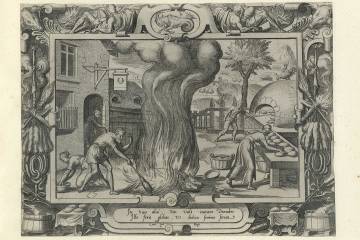The permanent exhibition American Origins, 1600-1900 occupies a long first-floor hallway of the National Portrait Gallery in Washington, with intimate pocket galleries that spur off it. Strolling through the installation provides a history of the country told through the paintings of some of the people who shaped it: John Winthrop, the English lawyer who helped start the Massachusetts Bay Colony in the early 1630s; John Morgan, the early 18th-century Philadelphia physician credited with professionalizing medicine in America. And then there are those figures familiar to us from history books: Benjamin Franklin. Thomas Jefferson. Alexander Hamilton. The paintings of these venerated figures are stately, on large canvases mounted in ornate, gilded frames. Everything about the presentation says these are important men. Esteemed men. White men.
Not every portrait here is a white guy—there are a few women, a few indigenous people (Seminole leader Osceola, Pocahantas, Shawnee leader Tenskwatawa), and a few people of color (performer Ira Aldridge, Frederick Douglass, Booker T. Washington)—but in portraiture, as in books, history tends to be written by the ostensible victors, the people with economic and political power to sell stories of a nation.
"When people walk into this museum and they're from a diverse background, and they don't see an image of somebody who looks like them, that's an incredibly disparaging experience," says Asma Naeem, who was the associate curator of prints, drawings, and media arts at the NPG from 2014 to 2018. Naeem, A&S '91, thinks art can, and should, be used to tell a broader, more inclusive narrative of our shared history. As a curator and art historian, "I was thinking about underrepresented people, whether they were gay or lesbian, whether they were people of color, whether they were women," she says. "Those became my focus areas. It's all about this idea of fairness, which is, I think, intrinsic to what I think is the ideal characteristic that we should all have."
Last fall, Naeem became the chief curator at the Baltimore Museum of Art, joining a curatorial team that BMA Director Christopher Bedford is putting together to rethink the history of postwar American art. His goal is to be more inclusive of a wider variety of artists, and since Bedford's arrival at the BMA in 2016, the institution has devoted more of its gallery space to exhibitions by women artists, queer artists, and artists of color. In 2018, the BMA launched a biennial public art commission and curatorial fellowship to cultivate the next generation of both international artists and museum leadership from more diverse backgrounds. The museum also made headlines last spring when it decommissioned seven works from its contemporary collection—including a Franz Kline—and used the proceeds to purchase contemporary art by underrepresented artists, including works by Carrie Mae Weems and Amy Sherald, who painted the official portrait of former first lady Michelle Obama.
"At the BMA we have a singular vision for our immediate future, which is to put equity, diversity, and justice at the forefront of every decision, to use it as a lens to inform our creative program just as we use it as a lens for vendor decision, just as we use it as a lens for acquisitions," Bedford says. "In casting around for my principal thought partner in crafting an institution aligned with those values, I felt extremely strongly that I wanted somebody who was pre-converted to the mission, and in Asma I found exactly that person."
Some artists and curators have been calling for museums to reassess their canons and collections at least since the 1960s, but only in recent years have museums such as the Los Angeles County Museum of Art, the Museum of Fine Arts, Boston, the Museum of Modern Art in New York, and others devoted more significant exhibition space and scholarship to underrecognized artists of color.
At the NPG, Naeem realized that "there's a lot of art history work to be done, and we're in a thrilling moment to be able to create these kinds of new dialogues and narratives" at museums, she says. "Traditional art histories are excellent in preparing new scholars, but there is a new direction that is needed."
Naeem, however, didn't arrive at her curatorial vision exclusively by looking at art history. Her path to the BMA ran through the New York City Criminal Court system, where she was an assistant district attorney from 1995 to 1999. Under then Mayor Rudy Giuliani and his police commissioner William Bratton, New York implemented a tough-on-crime "broken windows" approach to policing, aggressively enforcing laws prohibiting quality of life crimes such as graffiti, subway turnstile hopping, public loitering, and people looking to clean car windows with a squeegee for a buck at stoplights. Cleaning up such low-level, everyday "crimes" would, so the theory goes, lead to a reduction in a neighborhood's more serious criminal activity. And, for Naeem, this journey from prosecutor to art scholar helped calibrate her curatorial ideas. "I don't regret the pathway I took because it taught me a lot about myself," she says. "When I started at the Portrait Gallery, very quickly I saw the issues of historical inequities that can be found in art museums and I immediately responded to that. It was as if a light switch went off in me."
Born in Karachi, Pakistan, Naeem moved to Baltimore with her parents when she was young, and her physician mother became a resident at Franklin Square Hospital. She grew up and went to public schools in Baltimore's northern suburbs, and because she knew she was going to have to commute to college, local university Johns Hopkins was one of the few she applied to.
Naeem double majored in art history and political science as an undergrad. She first fell in love with art at Homewood thanks to art history classes with now Professor Emeritus Charles Dempsey and especially Yve-Alain Bois, a former faculty member currently at the Institute for Advanced Study in Princeton, New Jersey. She fondly recalls a class field trip Bois led to the Museum of Modern Art in New York. She always knew, however, that law school was on the horizon, and after she spent a year working for her aunt's law firm in Singapore, she enrolled at the Temple University Beasley School of Law.
She picked Temple for its successful moot court team, whose members argue imaginary cases in competitions, and for the program's emphasis on public service. "I knew that I wanted to go into criminal prosecution because I wanted to help people," she says. "I thought I could help victims of crime."

Image credit: André Chung
After graduation, she became an assistant district attorney in the Manhattan District Attorney's office, one of the country's largest municipal criminal prosecution offices. From 1995 to 1999, she was a prosecutor, working on misdemeanor cases her first year, and on felonies after that. "It was an intense period of my life," Naeem says. "I was suddenly in a courtroom by myself, representing the state of New York for jury trials, there was no one coaching me, it was really trial by fire. There were moments when the judge would say, 'Let's do an Allen charge,' [which is used] when there is hesitation for the jury to [reach] a verdict, and I had no idea what an Allen charge was. I had to learn very quickly."
The hours, she says, were intense. So were the courtroom personalities and the adversarial nature of the prosecutor-defender relationship. Soon, though, she found herself troubled by the zero-tolerance approach to crime fighting that considered everything from public urination to armed robbery as the same kind of societal ill. "I started to see shades of gray between bad and good that I couldn't reconcile in my head," she says, adding that it's too simplistic to paint all defendants as entirely bad and that there are challenges that people face in life that prosecutors aren't allowed to consider when adjudicating cases in court.
Naeem also started working domestic violence cases, and the intensity of these cases got to her. The last case she worked involved the rape of a teenager. He had been a straight-A student, but after being sexually assaulted he was put in the psychiatric unit at Bellevue Hospital. He committed a crime after he was released and was incarcerated. Naeem saw him when he was on the stand recounting his rape as a prisoner. "He testified as a convicted felon, and seeing the arc of his life, it broke me," Naeem says. "It really broke me. I think I cried in court that day."
When the stress got to be too much, Naeem would go to the city museums and galleries in her free time. During one museum visit, she saw an art journal with the name of her former art history professor Yve-Alain Bois on the cover. She loved art history as a student, yet she had never seriously considered it as a career. She recalls thinking, Why did I stop that?
She wasn't sure. What she did know was that she couldn't be a prosecutor anymore. In 1999 she and her husband, Babar Shafiq, moved back to Maryland. They both got jobs—he as a physical therapist with the Johns Hopkins Hospital, she as an assistant bar counsel, an attorney who investigates possible lawyer misconduct, in Washington—and Naeem quickly realized she was more interested in art than law. "I was constantly reading art books and going to art shows in my spare time, meeting with artists, dragging my husband to this gallery or that gallery," she says. She took an art history night class at American University, crashing on a friend's couch in D.C. once a week. Her son was born in 2001, and Naeem and Shafiq decided to do what any new parents would: make major career changes. He entered medical school at Howard University, and she pursued an art history master's at American en route to a doctoral program at the University of Maryland. Earning her PhD took about a decade, during which time they spent a year in Minneapolis and she gave birth to twin girls. As a graduate student who had already spent time in the professional world, she came to scholarship with a lawyer's focus. She was ravenous to learn and felt she had found her place. And slowly, she began to see how the inequities of the courtroom also appeared in art.
One of the exhibitions Naeem worked on during her time at the National Portrait Gallery is UnSeen: Our Past in a New Light, a two-person show featuring Ken Gonzales-Day and Titus Kaphar. Both Gonzales-Day and Kaphar create work that highlights how people of color are often left out of portraiture in art history, or appear merely as subservient figures somewhere in the background. Naeem co-curated the exhibition with NPG curator of Latino art and history Taína Caragol, who worked with Gonzales-Day, a Los Angeles–based artist and writer. Naeem worked with Kaphar, the painter and MacArthur fellow, whose work confronts African-American representation in art history and history writ large.
Kaphar's approach sifts through history's layers. He often paints in the richly photo-realistic tradition of portraiture and then slices into his canvas to reveal something behind the usual subject. His Behind the Myth of Benevolence is a portrait of Thomas Jefferson inspired by one by Rembrandt Peale made in 1800, only the top canvas has come away from its stretcher and hangs like a curtain, partially revealing another painting behind it: a black woman, whom we can only partially see, literally obscured by a white man.
Video credit: The Bholdr
Naeem included pieces from Kaphar's Jerome Project in UnSeen, too. These paintings are portraits of incarcerated African-American men named Jerome, based on their mug shots, rendered on gold leaf on wood panel like Byzantine religious icons, and dipped in tar that represents the amount of time they spent behind bars. Kaphar came across these men when he researched the prison records of his father, whose name is Jerome.
Witnessed in total, the project is a chilling comment on mass incarceration in America. "When I saw Titus' work I realized that my life had come full circle because I've seen the prison-industrial complex," she says. "I've seen the majority African-American population being arrested and prosecuted. This [work] is exactly the kind of intervention that the Portrait Gallery needs [in order] to address issues of absence, because we cannot tell the story of certain individuals because they never got their portrait made."
Naeem also curated Black Out: Silhouettes Then and Now at the Portrait Gallery, which drew on her interest in silhouettes as common folks' portraiture. This first major museum exhibition exploring the silhouette as an art form included works from back in the pre-photography days when cutout black figures on white paper portraits were the only way ordinary people had to reproduce a loved one's likeness on up to contemporary artists such as Kara Walker, who use them as a heady, creative vocabulary. "I've always found them absolutely fascinating," Naeem says. "It's using very simple language but conveys an immediate sense of a human being."
Black Out highlighted overlooked artists—such as Moses Williams, a formerly enslaved person who became a popular silhouette portraitist in the early 19th century—and portrait subjects, such as Flora, a 19-year-old woman who was bought for 25 pounds sterling on December 13, 1796. Her silhouette is included on the bill of sale, and it is one of the earliest renderings of an enslaved person in America we have. "I really like the democratizing element of silhouettes, how you didn't have to be a rich, land-owning person of power to have a portrait made," Naeem says. She also wondered: how did 19th-century white Americans feel about "seeing their portrait in black paper, or in black silk, during a time when blackness was being contested in the country?"
That question is impossible to answer, but it is worth being raised. In today's virtue-signaling political climate, discussions about the equity of representation are often lumped under the umbrella of social justice. Naeem prefers a more ordinary, if equally difficult to achieve, word when talking about society: fairness. It's an idea she says her parents ingrained in her growing up. She admits that her desire for it made her time as a prosecutor challenging. And the pursuit of it at a museum is what drew her to the BMA.
"We want to make a strong point that museums are materially relevant today, and the fact that Asma has a background in, and I mean this in the best possible sense, the real world, is deeply meaningful," Bedford says.
In February, the BMA announced that a gift by Baltimore-based philanthropists is endowing the chief curator position, and Naeem became the Eddie C. and C. Sylvia Brown Chief Curator. It is one of the few museum positions named for an African-American couple. That distinction may seem like a shrewd bit of public relations, but for Bedford, looking at all the BMA's operations through the lenses of equity and diversity isn't simply about reassessing what's on the walls and in the collections. It's about expanding who comes to the museum as well.
"When one looks at typical visitation rates at museums, it comes as no surprise that museum visitation has been white majority with additional bias toward middle and upper-middle classes," Bedford says. "I think our deepest conviction is that art is an intensely democratic enterprise and is for absolutely everyone. So in order to grow audiences and become relevant, we have to reach an entirely different audience than has been our emphasis, and that is a conviction that both Asma and I share really deeply."

Image credit: University of California Press
When researching her dissertation—a look at how sound and technology were depicted in mid-19th-century American painting, set to be published by the University of California Press later this year as Out of Earshot: Sound, Technology, and Power in American Art, 1860–1900—Naeem realized that when Americans first started forming art museums in the 19th century, they didn't look or feel like they do today. "They had this P.T. Barnum-esque quality to them," she says. She adds that American museums in the 1800s offered something for the whole family, a description that brings to mind the more proletarian movie theaters of recent memory that have been replaced by so-called luxury seating and cinema amenities, an upscaling that museums—and symphony halls and theater houses—underwent in the 20th century. If you grew up thinking a museum or concert hall was too fancy for a middle-class commoner like yourself, that attitude was manufactured by museum and symphony leadership to appeal to a certain type of person.
"I think that it's incumbent upon museums to try to reactivate our institutions as a place for people of all backgrounds, as a place for expressing opinions and having different voices, and not feeling like they have to be quiet," she continues. "I'm very interested in trying to make people who never would think of walking through our museum doors feel like they can come in and be welcome."
Correction: An earlier version of this article included the incorrect time period for the art involved in Naeem's dissertation. The magazine regrets the error. The story also states that Naeem included pieces from Titus Kaphar's Jerome Project in the Unseen exhibit at the National Portrait Gallery. The Titus Kaphar pieces she included were similar to, but not from, the Jerome Project.
Posted in Arts+Culture, Alumni
Tagged alumni, art, art history, baltimore museum of art










